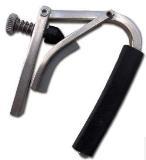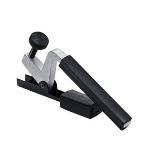I wanna buy the first capo for my acoustic guitar, and I'm just wondering if there are many types of capo .. I mean .. if I went to a shop, can any capo work ? Or is there a difference?
2 Answers
That's a great question! There are in fact many different types of capo and they all have advantages and disadvantages. I own at least 6 different kinds. I will highlight the main differences and advantages of each.
As Leftaroundabout explained, no matter which style/type capo you get, you want it to match your fretboard for width and curvature. Beyond getting that part right let's talk about your options and the advantages of each.
The most commonly used capo in my part of the world among all the musicians I know is one of the spring clamp varieties also known as "quick change" capos. A popular version of this type capo is made by Kyser (see picture below).
This type capo has a spring in it and you open it to put it on the guitar neck by squeezing the trigger (these are sometimes referred to as a "trigger capo"). Releasing the pressure allows the capo to clamp on the guitar neck with spring tension. It works much like a spring operated clothes pin. The reason many performing musicians use this type is that it can be installed, removed and repositioned very quickly with one hand. There are no screws to tighten or levers to latch. Also it can be clamped on the headstock or mic stand or music stand for easy accessibility during the performance.
The disadvantage of this type capo is that you cannot adjust the tension. A similar capo that I prefer is known as a "dual action" capo like the one made by Planet Waves pictured below.
This capo works much the same as the Kyser style spring clamp in that you can store it on the headstock and install and remove it with one hand. But it has a tension adjustment knob that allows you to adjust the tension for your guitar. Different guitars have different neck thicknesses and the dual action capo allows you to adjust the amount of pressure on the strings so that you have just enough to get all strings ringing clearly with no muting but not so much that the strings are pinned tight against the fret board and pulled out of tune.
Another capo I own is a Paige Capo - pictured below.
What I like best about this capo is that it is very thin (the thinnest I am aware of). It gives your fingers more room for chords such as a B7 where you are fretting on the first and second fret using all four fingers. Another advantage is that the tension is adjustable for the exact amount needed to deliver clean sounding open strings with no more tension than necessary. It can be fined tuned better than the dual action because there is no spring tension involved.
The disadvantage of the Paige capo is that it takes two hands to install or remove or move it. You must open the lever with one hand while holding on to the capo with the other hand. Also, if you move the capo up the neck where it is thicker, you have to adjust the tension screw. I use this capo when I am going to be playing most songs in my performance with the capo in the same position. It's also the best capo to use if you want to reduce overall string tension by shortening the scale of your guitar by tuning a half step flat and leaving the capo on the first fret all the time.
Another thin bar capo that allows more room for certain chords but is a tad more easily moved than the Paige - is the Shubb (pictured below).
Like the Paige, this one does not use a spring (uses a type of lever action) so the tension can be fine tuned, but it has a trigger style release that allows for one handed removal (although installing it with one hand is rather tricky). It takes less time to install than the Paige, once you adjust the tension screw properly for your guitar.
Another adjustable tension capo with a sleek design is the G-7th Capo (pictured below).
This capo works with an internal ratchet type mechanism. You place it on the neck and press down on the string bar as far as needed to get clean tone and the mechanism holds it in that position until you release it with the release lever. This allows you to install and remove it with one hand as long as you are not too clumsy. It takes getting used to how hard to squeeze it to get the correct tension, but some folks seem to love this capo.
If you are on a budget, the capo pictured below is very inexpensive and does the job and is very light weight.
And if you are on a really tight budget, the elastic band type capo is quite versatile in terms of fitting many different type guitars. It is not fine tunable and it takes two hands and one leg and an elbow to install and remove.
Once you get your capo, you will find the chart in the link below very useful for determining where to place the capo for various transpositions.
-
It seems like the "dual action" capo is the best , isn't it ?– user28116Commented May 3, 2016 at 18:48
-
@Eva - I like it for it's functionality when new - but with more parts it has a higher probability of eventual failure and thus needing replacement. The part that seems to wear out is the tension adjustment mechanism. Mine has lasted quite some time but I have a friend who has one that wore out. I will buy another one though if mine ever does fail because I really like it. Commented May 4, 2016 at 4:29
-
How well do the different capos work as five-string capos? For pieces that are capoed on the 2nd fret, leaving the low E string open allows the D-shape (E) chord to be played with all six strings, and the only disadvantage is that E-shape (F) chords must be played with an extra finger fretting the low E string on the second (capo) fret.– supercatCommented May 19, 2016 at 4:08
-
@supercat The best capo for leaving the low E (6th string) open is a spring clamp like the Kyser or a dual action like the planet waves. The other capos work better when the opposing stabilizer is centered at the back of the neck. They do make partial (cut) capos that are designed to clamp across fewer than 6 strings. You can use two capos if you want to achieve a capoed drop D tuning effect on the 3rd or 4th or higher fret. For example you can put a full capo on the 2nd fret and a partial capo on the 4th fret. Commented May 19, 2016 at 8:50
Most of them will probably work, but there sure are some differences.
- Fingerboard shape: there's a rough distinction in flat fingerboards (most nylonstring guitars) and curved (steelstring). Using a curved capo on a classical guitar will either excert unnecessary pressure to the outer strings, or fail to press the inner ones down reliable; vice versa a flat capo may result in either detuning of the inner strings through too much, or rattling on the bass strings through too little pressure.
- Related: different guitars have different neck widths. Standard capos won't work on sevenstring guitars (at least not on all strings). But most capos will have the right size to work on almost any normal sixstring guitar.
- Some capos (e.g. Dunlop Trigger) just press down the strings with a spring, which can be very quickly released with one hand. Others (e.g. Shubb) can be adjusted to fit the neck thickness, which can solve some intonation- or buzzing problems, but is also slightly more fiddly. (I think some capos even let you fine-tune the shape.)
Several cheap models just clamp the neck with some kind of ratched mechanism, which is neither really stable nor very accurate nor easy to set up.
As with all music purchases, the best thing is to try out the available models, see what fits well your guitar.
-
1I have each a Kyser, Shubb, and G7 capo and I like them for different needs on different guitars. Personally the Kyser is my least favorite since there is only one tension available. Commented Apr 30, 2016 at 21:54
-
@ToddWilcox My favorite is the planet waves pictured in the answer I just posted. It's best of both worlds - easily installed or moved and clamps on headstock - but adjustable tension. The adjustment springs do wear out over time however. My second favorite is my aluminum red Shubb that is super light weight. Commented Apr 30, 2016 at 23:07







